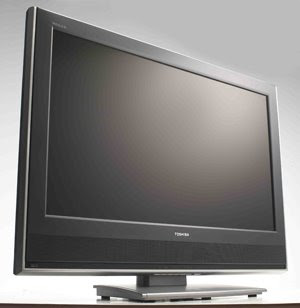Television
From Wikipedia, the free encyclopedia
Television is a widely used telecommunication medium for sending (broadcasting) and receiving moving images, either monochromatic ("black and white") or color, usually accompanied by sound. "Television" may also refer specifically to a television set, television programming or television transmission. The word is derived from mixed Latin and Greek roots, meaning "far sight": Greek tele (τῆλε), far, and Latin vision, sight (from video, vis- to see, or to view in the first person).
Commercially available since the late 1930s, the television set has become a common communications receiver in homes, businesses and institutions, particularly as a source of entertainment and news. Since the 1970s, recordings on video cassettes, and later, digital media such as DVDs, have resulted in the television frequently being used for viewing recorded as well as broadcast material.
A standard television set comprises multiple internal electronic circuits, including those for tuning and decoding broadcast signals. A display device which lacks these internal circuits is therefore properly called a monitor, rather than a television. A television set may be designed to handle other than traditional broadcast or recorded signals and formats, such as closed-circuit television (CCTV), digital television (DTV) and high-definition television (HDTV).
History
In its early stages of development, television included only those devices employing a combination of optical, mechanical and electronic technologies to capture, transmit and display a visual image. By the late 1920s, however, those employing only optical and electronic technologies were being explored. All modern television systems rely on the latter, however the knowledge gained from the work on mechanical-dependent systems was crucial in the development of fully electronic television.
In 1884 Paul Gottlieb Nipkow, a 20-year old university student in Germany patented the first electromechanical television system which employed a scanning disk, a spinning disk with a series of holes spiraling toward the center, for "rasterization", the process of converting a visual image into a stream of electrical pulses. The holes were spaced at equal angular intervals such that in a single rotation the disk would allow light to pass through each hole and onto a light-sensitive selenium sensor which produced the electrical pulses. As an image was focused on the rotating disk, each hole captured a horizontal "slice" of the whole image.
Nipkow's design would not be practical until advances in amplifier tube technology became available in 1907. Even then the device was only useful for transmitting still halftone images - those represented by equally spaced dots of varying size - over telegraph or telephone lines. Later designs would use a rotating mirror-drum scanner to capture the image and a cathode ray tube (CRT) as a display device, but moving images were still not possible, due to the poor sensitivity of the selenium sensors.
Scottish inventor John Logie Baird demonstrated the transmission of moving silhouette images in London in 1925, and of moving, monochromatic images in 1926. Baird's scanning disk produced an image of 30 lines resolution, barely enough to discern a human face, from a double spiral of lenses.
By 1927, Russian inventor Léon Theremin developed a mirror drum-based television system which used interlacing to achieve an image resolution of 100 lines.
Also in 1927, Herbert E. Ives of Bell Labs transmitted moving images from a 50-aperture disk producing 16 frames per minute over a cable from Washington, DC to New York City, and via radio from Whippany, New Jersey. Ives used viewing screens as large as 24 by 30 inches (60 by 75 centimeter). His subjects included Secretary of Commerce Herbert Hoover.
(This summary drawn from History of television remains incomplete. See Talk:Television "Move "History of television" into this article."
Social aspects
Television has played a pivotal role in the socialization of the 20th and 21st centuries. There are many social aspects of television that can be addressed, including:


No comments:
Post a Comment